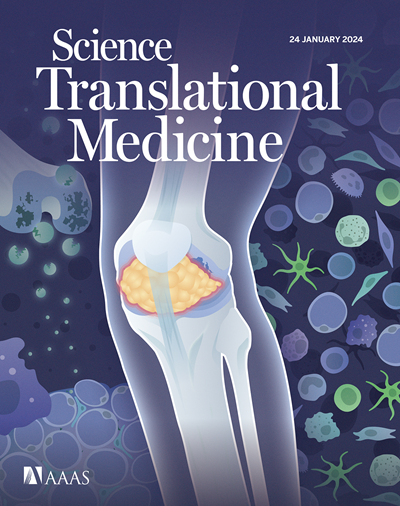广泛中和抗体,靶向人类诺如病毒大流行GII.4变种或7种GII基因型
IF 15.8
1区 医学
Q1 CELL BIOLOGY
引用次数: 0
摘要
人类诺如病毒每年导致7亿多人患病。广泛的遗传多样性和保守的中和性表位信息的缺乏是设计广泛保护性诺如病毒免疫原的主要障碍。在这里,我们使用高分辨率液相色谱-串联质谱(LC-MS/MS)驱动的蛋白质组学,定量表征了实验性单价诺如病毒GII.4 VP1衣壳编码腺病毒疫苗免疫前后的循环血清IgG库。根据跨GII.4变异(参与者A)或跨GII基因型(参与者B)的血清中和反应的广度,专门选择了两名参与者。在参与者A中,疫苗接种反增强了高度丰富的血清抗体克隆型,靶向在快速进化的GII.4变异(从1987年鉴定的菌株到2019年鉴定的菌株)中保守的表位。在参与者B中,我们发现了由广泛中和的单克隆抗体组成的召回反应,具有显著的跨GII配体结合阻断(阻断≥7个GII基因型)和病毒中和广度。其中一种抗体VX22与VP1衣壳突出(P)结构域复合物的共晶结构在P1亚结构域的两个侧环内显示出高度保守的表位(残基479至484和509至513)。抗体进化轨迹分析进一步表明,VX22最初是从早期异源感染进化而来,可能是由GII.12菌株引起的。总之,我们的研究表明,在腺病毒载体疫苗免疫后,具有广泛GII.4效力和跨gii广度的诺如病毒人单克隆抗体可以在血清中增强,这一发现可能指导广泛保护性诺如病毒疫苗免疫原的设计。本文章由计算机程序翻译,如有差异,请以英文原文为准。
Broadly neutralizing antibodies targeting pandemic GII.4 variants or seven GII genotypes of human norovirus
Human norovirus causes more than 700 million illnesses annually. Extensive genetic diversity and a paucity of information on conserved neutralizing epitopes pose major obstacles to the design of broadly protective norovirus immunogens. Here, we used high-resolution liquid chromatography–tandem mass spectrometry (LC-MS/MS)–driven proteomics to quantitatively characterize the circulating serum IgG repertoire before and after immunization with an experimental monovalent norovirus GII.4 VP1 capsid–encoding adenoviral vaccine. Two participants were specifically selected on the basis of the breadth of serum neutralization responses either across GII.4 variants (participant A) or across GII genotypes (participant B). In participant A, vaccination back-boosted highly abundant serum antibody clonotypes targeting epitopes conserved among rapidly evolving GII.4 variants spanning from a strain identified in 1987 to a strain identified in 2019. In participant B, we identified a recall response consisting of broadly neutralizing monoclonal antibodies with remarkable cross-GII ligand-binding blockade (blocking ≥ seven GII genotypes) and virus neutralization breadth. The cocrystal structure of one of these antibodies, VX22, in complex with the VP1 capsid protruding (P) domain revealed a highly conserved epitope (residues 479 to 484 and 509 to 513) within two lateral loops of the P1 subdomain. Antibody evolutionary trajectory analysis further revealed that VX22 had originally evolved from an early heterologous infection, likely by a GII.12 strain. Together, our study demonstrates that norovirus human monoclonal antibodies with broad GII.4 potency and cross-GII breadth can be boosted in serum after immunization with an adenoviral vector–based vaccine, findings that may guide the design of immunogens for broadly protective norovirus vaccines.
求助全文
通过发布文献求助,成功后即可免费获取论文全文。
去求助
来源期刊

Science Translational Medicine
CELL BIOLOGY-MEDICINE, RESEARCH & EXPERIMENTAL
CiteScore
26.70
自引率
1.20%
发文量
309
审稿时长
1.7 months
期刊介绍:
Science Translational Medicine is an online journal that focuses on publishing research at the intersection of science, engineering, and medicine. The goal of the journal is to promote human health by providing a platform for researchers from various disciplines to communicate their latest advancements in biomedical, translational, and clinical research.
The journal aims to address the slow translation of scientific knowledge into effective treatments and health measures. It publishes articles that fill the knowledge gaps between preclinical research and medical applications, with a focus on accelerating the translation of knowledge into new ways of preventing, diagnosing, and treating human diseases.
The scope of Science Translational Medicine includes various areas such as cardiovascular disease, immunology/vaccines, metabolism/diabetes/obesity, neuroscience/neurology/psychiatry, cancer, infectious diseases, policy, behavior, bioengineering, chemical genomics/drug discovery, imaging, applied physical sciences, medical nanotechnology, drug delivery, biomarkers, gene therapy/regenerative medicine, toxicology and pharmacokinetics, data mining, cell culture, animal and human studies, medical informatics, and other interdisciplinary approaches to medicine.
The target audience of the journal includes researchers and management in academia, government, and the biotechnology and pharmaceutical industries. It is also relevant to physician scientists, regulators, policy makers, investors, business developers, and funding agencies.
 求助内容:
求助内容: 应助结果提醒方式:
应助结果提醒方式:


